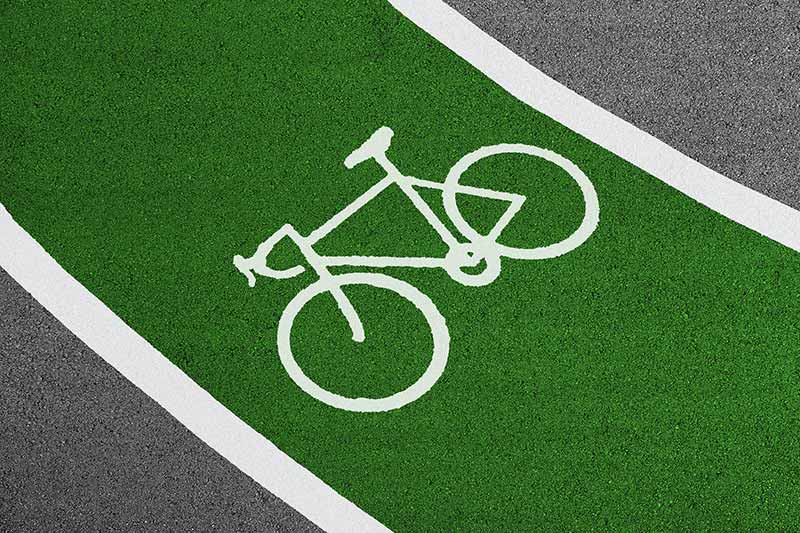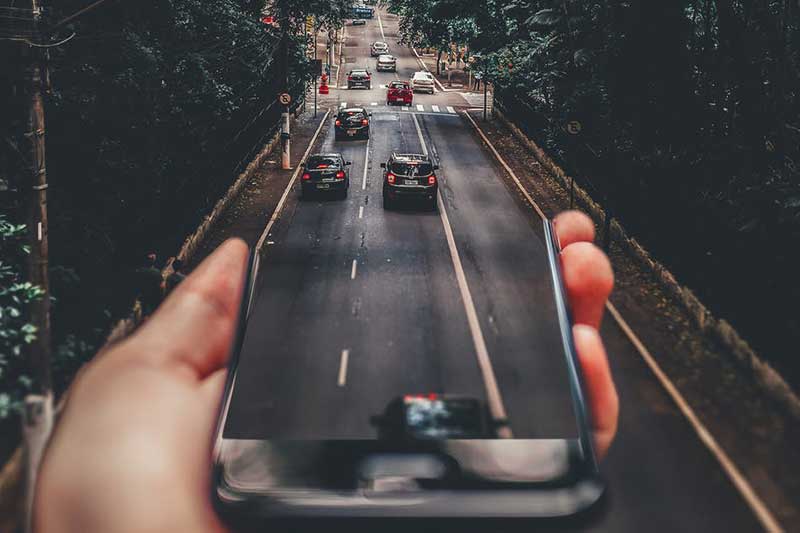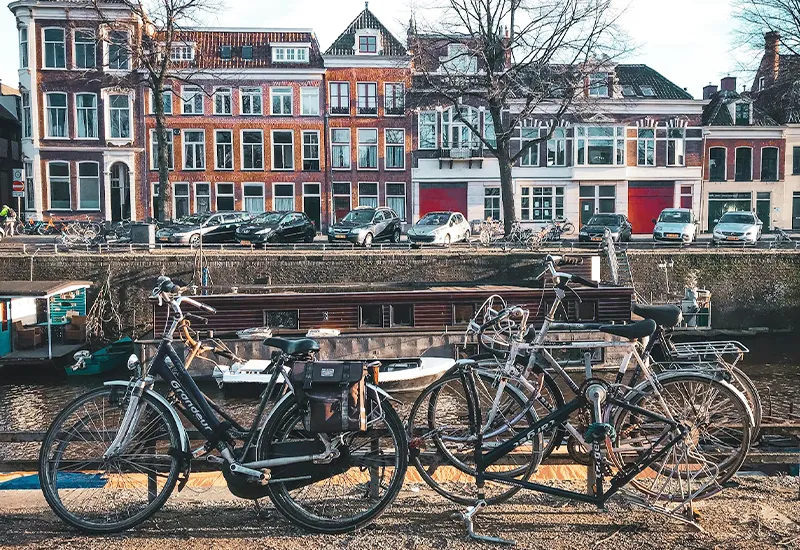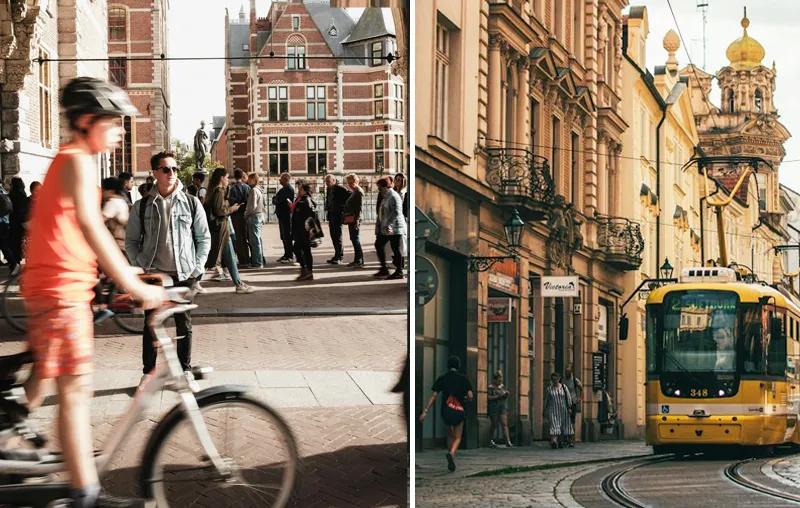What does soft mobility actually mean? Wenn du eine klare Antwort auf diese Frage suchst, bist du hier genau richtig. Einige der biggest environmental problems of our time sind eine logische Folge davon, wie wir Menschen uns fortbewegen. Ich denke da zum Beispiel an die Luftverschmutzung in den Städten durch den Autoverkehr – und nicht zuletzt die global warming, die ganz allgemein vom menschlichen Ausstoß an Treibhausgasen angetrieben wird.
Die sanfte Mobilität ist ein Konzept für eine menschen- und umweltverträgliche Fortbewegung und setzt eben genau an diesen Problemen an. Und mit Sicherheit bist du beispielsweise bei einer Dokumentation über den Mass tourism oder bei der Suche nach Urlaubsangeboten auch schon einmal über den Begriff gestolpert.
In diesem Artikel möchte ich dir jetzt erläutern, was genau unter sanfter Mobilität zu verstehen ist. Von der Definition, über die Vorteile, konkrete Maßnahmen und entscheidende Fortbewegungsmittel, bis hin zu den Orten, die es bereits aktiv vorleben. Auf geht's!
Definition: Was ist sanfte Mobilität?

Hinter dem Begriff der sanften Mobilität verbirgt sich ein politisches Konzept, dass auf einen umweltfreundlicheren Verkehr abzielt. So sollen insbesondere Urlaubsregionen und Innenstädte weitaus nachhaltiger, umweltschonender und sozialverträglicher – und auch die Unfallquote erheblich reduziert werden.
Im Rahmen der sanften Mobilität werden deshalb umweltfreundliche Formen der Fortbewegung gefördert, um sinnvolle Alternativen zur Autonutzung zu schaffen. Diese beinhalten unter anderem die Förderung der Nutzung der öffentlichen Verkehrsmittel (Bahn, Bus, Tram usw.), die Akzeptanz und Nutzung von Sharing-Konzepten, the Cycling und natürlich auch das Zufußgehen.
The Auto (bzw. Taxi) soll hingegen nur im vernünftigen Ausmaß (also sozusagen sinnvoll ergänzend bzw. lückenfüllend) zum Einsatz kommen.
Tip: Apropos Sharing! Schau dir auch gern mal meinen Beitrag über die E-scooter sustainability an. In it, you'll learn how to use them in the most environmentally friendly and healthy way possible.
Gründe: Warum ist das Konzept der sanften Mobilität überhaupt notwendig?

Das Konzept der sanften Mobilität hat sich als Reaktion auf verschiedene Herausforderungen im Bereich der Verkehrsplanung und Verkehrspolitik entwickelt.
Hier sind einige von vielen zentralen Gründen, die die Notwendigkeit für diesen lösungsorientierten Ansatz verdeutlichen:
- Einseitige Lobbyarbeit: Der motorisierte Individualverkehrs (MIV) hat in Deutschland seit vielen Jahrzehnten eine extrem einflussreiche Lobby. Seine Förderung ging zu Lasten anderer, umweltverträglicherer Verkehrsformen, weshalb nun eine umfassende Planung für nachhaltigere Mobilitätsformen unausweichlich ist.
- Ausgebaute Straßensysteme: Wenn das Straßennetz kontinuierlich erweitert wird, nutzen auch viele Menschen das verbesserte Angebot – und ziehen die Autofahrt nachhaltigen Alternativen, wie der Nutzung des öffentlichen Nahverkehrs, vor.
- Massentourismus: Staus, überlastete Innenstädte und zerstörte Naturlandschaften sind nur einige Folgen davon, dass manche Urlaubsregionen sprichwörtlich von Reisenden überflutet werden. Die sanfte Mobilität bzw. der sanfte Tourismus erfüllen dahingehend auch eine beruhigende und entschleunigende Funktion.
- Kosten für Allgemeinheit: Ein Fahrzeug verursacht nicht nur Kosten für den Bau und den Unterhalt. Seine bevorzugte Nutzung sorgt auch für Kosten als Folge der Umwelt-, Flächenbelastung und Unfälle, die im Regelfall von der Allgemeinheit getragen werden. Die sanfte Mobiltiät zielt deshalb auch darauf ab, die Externalization of environmental costs zu reduzieren und für Gerechtigkeit zu sorgen.
Vorteile: Was sind die wichtigsten Gründe für die sanfte Mobilität?
Die Befürworter einer sanften Mobilität rechtfertigen das Konzept der Verkehrswende unter anderem mit dem erhöhten Verkehrsaufkommen in den Städten. Die Infrastruktur ist diesem nicht gewachsen und somit kommt es häufig Staus und Stop-And-Go-Verkehr. Zu beobachten ist dieses Phänomen insbesondere in der Nähe von Freizeiteinrichtungen, Einkaufsmöglichkeiten und Erholungsgebieten.
Einer der wesentlichen Vorteile der sanften Mobilität ist deshalb vor allem, dass ein unnötig hohes Verkehrsaufkommen durch die Förderung platzsparender, alternativer Fortbewegungsformen vermieden wird.
Weil die Straßen in den Innenstädten für Fußgänger:innen zur Verfügung stehen, werden auch mögliche Auseinandersetzungen zwischen unachtsamen Fußgängern und Autofahrern automatisch reduziert.
Es gibt wirklich unzählige Gründe für die sanfte Mobilität. Hier habe ich dir deshalb eine übersichtliche Liste der wichtigsten Vorteile compiled:
- Less congestion and stop-and-go traffic
- Die Nutzung emissionsarmer Verkehrsmittel wird attraktiver
- Car-free areas encourage the influx of young families with children
- Promotion of public transport
- Attractive city concepts reduce the need for outbound travel
- Erholsamere, ruhigere Innenstädte
- Förderung sozialer Gerechtigkeit durch Zugänglichkeit
- Erhöhte Verkehrssicherheit
- Verbesserte Luftqualität in Ballungsgebieten
- Sustainable urban and regional development
Tip: In this context, be sure to check out the post about the Life without car an! Natürlich funktioniert das nicht für jeden von uns – doch immer mehr Menschen kommen mittlerweile ganz ohne eigenes Kfz aus.
Hat die sanfte Mobilität auch Nachteile?
Vertreter:innen der konventionellen Verkehrspolitik verweisen vor allem darauf, dass Menschen mit dem Auto direkt vor die Haustür bzw. direkt an ihr Ziel kommen, ohne die letzten Meter anderweitig zurücklegen zu müssen. Auch die Umsatzverlusten für die örtliche Wirtschaft, als Folge des ausbleibenden Pkw-Verkehrs, wird oft genannt.
Doch meiner Meinung nach kennt die sanfte, nachhaltige Mobilität eigentlich nur Gewinner:innen. Denn das Leben in Städten wird attraktiver, gesünder, umweltfreundlicher und sicherer. Das Konzept entschleunigt unseren Alltag und ist vor allem ein zukunftsorientiertes Mittel gegen die air pollution und andere ökologischen Herausforderungen unserer Zeit.
Wenn man etwas tatsächlich als Nachteil der sanften Mobilität bezeichnen kann, dann ist es sicherlich die Kostenintensität der Veränderungen im urbanen Raum. But since it makes our lives better in the long run, it's probably more of an investment than a cost.
Maßnahmen: Wie lässt sich das Konzept der sanften Mobilität in der Praxis stategisch umsetzen?

Im Rahmen der sanften Mobilität entwickelt man Strategien, die der Verkehrswende dienen. All jenes mit dem Ziel, die Lebensqualität in der Stadt bzw. in einer bestimmten Urlaubsregion zu erhöhen.
Dafür sollen beispielsweise Fördermittel für den Flugverkehr reduziert und stattdessen der Expansion of infrastructure for bicycles forciert werden. Auch ein günstiger oder sogar kostenloser Nahverkehr mit Bus- und Bahn kann dabei eine wesentliche Rolle spielen.
Also the Anreize, bei Bedarf ein emissionsarmes, elektrisches Auto zu finanzieren bzw. zu nutzen, werden im Sinne der sanften Mobilität durch politische Maßnahmen erhöht. So wird zum Beispiel die Mineralölsteuer angehoben – die Steuereinnahmen finanzieren dann beispielsweise die Parkraumbewirtschaftung.
Die sanfte Mobilität zielt sogar auf einen Road reconstruction ab, damit die Natur deutlich mehr Platz hat und es zu einer Verkehrsberuhigung kommt. Durch kürzere Wege lässt sich außerdem eine Zersiedelung des Umlandes verhindern.
Good to know: Auch die Bildung von Fahrgemeinschaften durch Reiseveranstalter:innen oder private Reisegruppen (z.B. vom Bahnhof zur Reiseunterkunft) reduziert Autofahrten. Auch das ist also eine sinnvolle Maßnahme im Sinne der sanften Mobilität.
Tourismus: Welche positiven Beispiele gibt es für sanfte Mobilität in Urlaubsregionen?
Zugegeben: Es gibt noch nicht viele herausragende Beispiele für das Konzept der sanften Mobilität. Doch einige Städte leben vor, wie es funktionieren kann!
Ein sehr gutes Beispiel ist die österreichische Stadt Werfenweng. Wer mit dem Bus oder der Bahn anreist, bekommt dort vor Ort automatisch eine Gästekarte. Mit dieser sogenannten „SAMO-Card“, kann dann das Werfenweng-Shuttle, sowie der gesamte E-Fuhrpark der Stadt genutzt werden.
Ein europaweites, einheitliches Ticket-System für den öffentlichen Nahverkehr könnte die Entwicklung beispielsweise auch in anderen Städten beschleunigen. Noch nie zuvor in der Geschichte gab es eine Reisefreiheit wie heute. Und durch die Förderung oder Vereinheitlichung des öffentlichen Nahverkehrs, kann diese Freiheit sinnvoll ergänzt werden. In Deutschland ist deshalb auch das 49 euro ticket ein positives Beispiel.
Sanfte Mobilität – Gemeinsam umweltfreundlich fortbewegen!
Die sanfte Mobilität ist definitiv das Konzept für die Mobilität der Zukunft. Die Vorteile für Mensch und Umwelt überwiegen den wenigen Nachteilen und Herausforderungen. Insbesondere die Verbesserung der Luftqualität, die Entlastung vom Pkw-Verkehr und die Nutzung klimafreundlicher, erneuerbarer, also nicht-limitierter Energien, wie Strom aus Solar-, Wasser- und Windkraft, machen dieses Konzept so zukunftsfähig.
"The beaten path is the safest, but the traffic’s terrible."
Jeff Taylor (mehr unter Mobility Quotes)
Finally, I would like to give you some weiterführende Artikel aus dem Blog ans Herz legen, die unmittelbar mit einer umweltfreundlichen Art der Fortbewegung in Verbindung stehen:
- Nachhaltiger Arbeitsweg – Das kann jeder tun
- Umweltbewusst Autofahren – Die besten Tipps
- Nachhaltig leben in der Stadt – So geht's
Hast du Fragen, Anregungen oder eigene Erfahrung mit der Idee der sanften Mobilität gemacht, die du teilen möchtest? Dann schreib mir einfach einen Kommentar.
Stay sustainable,

PS: In my Mobility Blog erfährst du noch so viel mehr über die Möglichkeiten, unsere Art der Fortbewegung nachhaltiger zu gestalten. Schau dir als Nächstes zum Beispiel meine Tips for sustainable travel an – und nutze sie direkt im nächsten Urlaub.








